労働者と資源:ソビエト共和国 – 究極の複雑な交通ガイド
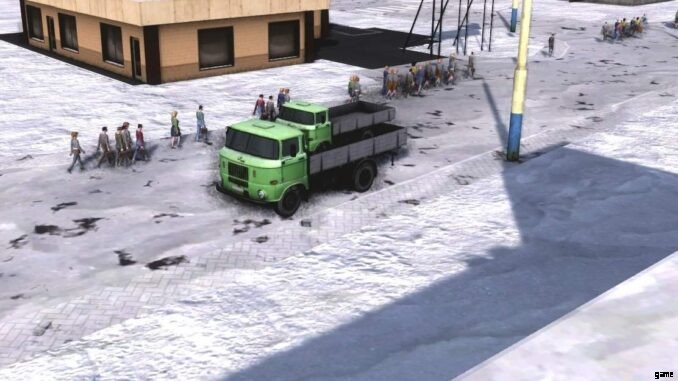
このガイドは、アップデート #10 (0.8.7.8) で追加された交通標識の詳細な内訳です。各交通標識がどのように機能するか、および基礎となる交通ロジックについて説明します。さらに、システムでできることの例をたくさん追加しました。このガイドは、労働者と資源:ソビエト共和国に関する基本的な知識と、実際の交通の仕組みを理解していることを前提としています。
概要
使い方
まず、新しいマップを開始するとき、またはゲームの実行中に、ゲームプレイ オプションで複雑なトラフィックを有効にする必要があります。アクティブにしても目立った欠点はありません。アクティブ化されたとしても、どれだけ関与したいかについてのオプションの選択のままです.
現在のすべての兆候
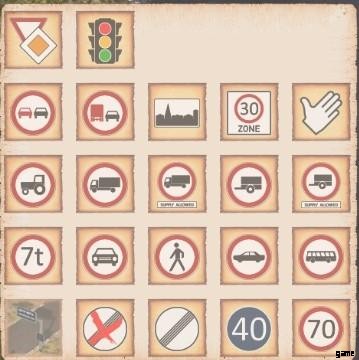
これらの兆候は、基本的に次の 2 つのカテゴリに分類できます。
- 規制標識
- ゾーン
- 優先標識と信号機
すべての道路標識は、道路/街路カテゴリのウェイポイントの下にあります。

規制標識とゾーン標識の両方が道路に設置されています。優先標識と信号機が交差点に配置 (または作動) されます。
規制標識
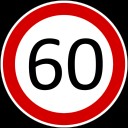
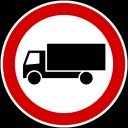
規制標識は、道路脇に置く標識であり、通過する車両が従うことを強制されるか、そもそも通過することを禁止します (個々の車両の交通ロジックについては、以下で詳しく説明します)。ほとんどの標識は、常識と現実世界の交通法の基本的な理解があれば自明ですが、それでも 1 つずつ説明します。
規制標識を 2 つのカテゴリに分類します。
- 分節記号
- 制限標識
標識は少なくとも砂利道以上が必要で、泥道には設置できません。
2 つの標識を重ねて配置できます。何らかの理由でより多くの記号が必要な場合は、間隔をあける必要があります。さらに、1 つの記号を配置すると、別の記号が上書きされる可能性があります。 「No Motor Vehicles」標識を「No Buses」標識の上に配置すると、単に「No Buses」が上書きされます。
村の砂利道がより大きなアスファルト道路につながる仮説的な例:
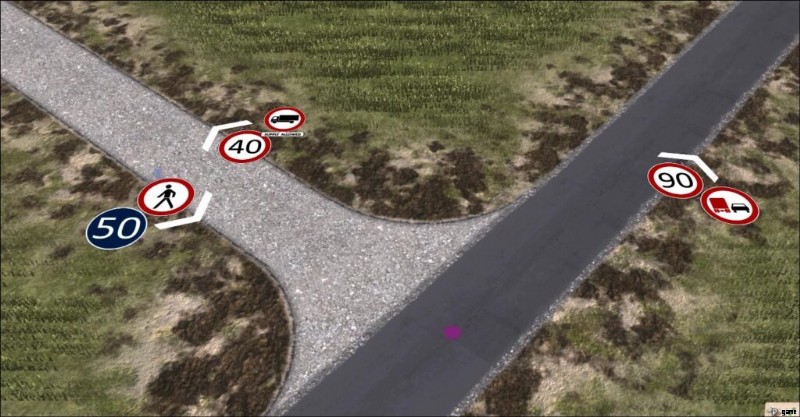
アスファルト道路は時速 90 km の速度制限があり、大型トラックの追い越しは禁止されています。
砂利道は時速 40km の速度制限があり、物資を運ぶトラックのみが通行できます。
歩行者はアスファルト道路に入ることができず、アスファルト道路に乗りたい車両は、少なくとも時速 50 km で走行できる必要があります。
分節記号
セグメント標識は、標識を通過するとすぐに車両に適用され、残りの道路セグメントに対して有効のままです。
ただし、これは、標識のルールが次のノードまでしか適用されないことも意味します。これらの標識は、より長い道路セグメントに対してのみ有用であり、道路セグメントごとに「再適用」する必要があるためです。
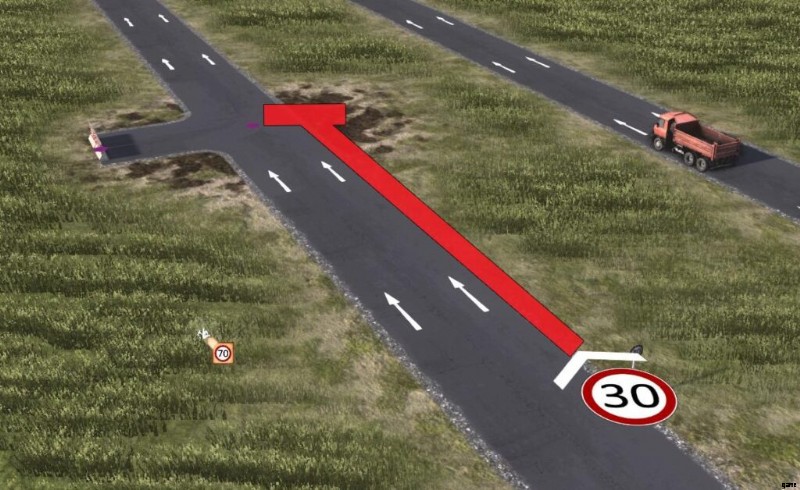
最高速度



最高速度標識は、通過するすべての車両に制限速度を適用します。それらは、特定の道路の魅力を低下させたり、スピードスターを減速させたり、ロールプレイングの目的でより均一な速度を強制したりするために使用できます.
最大速度は、E/Q (またはブリッジの高さの増減にバインドされているもの) を押すことで増減できます。
追い越し禁止


車両は他の車両を追い越すことはできません。この標識には 2 つのバージョンがあります。1 つは、すべての車両によるすべての車両の追い越しを禁止するもので、もう 1 つは大型車両の追い越しのみを禁止しますが、小型車などの低速車両の追い越しは許可します。
この標識は、ある車両が他の車両を追い越そうとするアコーディオン効果の発生を防ぐのに役立ちます。追い越された車両またはその後ろの車両が完全に停止し、後続の車両も完全に停止することを余儀なくされます。停車し、多数の車両に波及効果を引き起こし、小さな交通渋滞を引き起こします。
制限の終了

デフォルトの速度制限に戻し、車両が互いに追い越しできるようにします。
制限標識
制限標識は非常に単純です。入ることが許されないなら、入ることは許されません。そして、共和国の輝かしい遠隔操作の自律型 GPS ドローン車両は、すべての規則に従い、その先にあるものを知っています。
これは、これらの道路の両方が同じ結果になることを意味します:
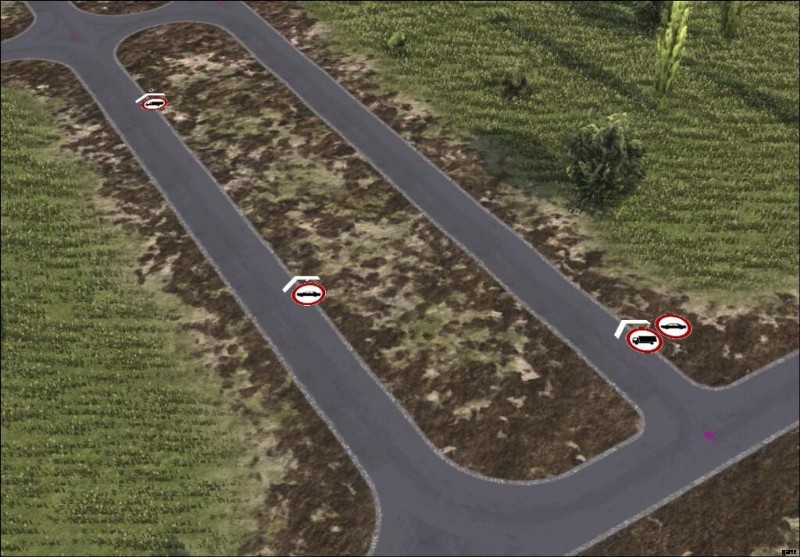
したがって、現実的には制限標識は交差点や通りの入り口にありますが、ゲームではセグメントのどこにでも配置できます。これらの規則にはいくつかの特別な例外があります。これについては、このセクションの最後で説明します。
農業用車両禁止

すべての農業用車両の通過を制限します。これは車両やトラクターの収穫を意味します。
重量物運搬車禁止

すべての重量物運搬車を制限します。これは、オープンまたはクローズドの大型トラック、ダンパー、タンカーなどを意味します。自家用車、バスなどが通行できます。
トレーラーを引っ張る車両禁止

タイプに関係なく、何らかの形式のトレーラーを運ぶすべての車両を制限します。これは、たとえば、LZ 100 は許可されていますが、LZ 100 (トレーラー) と LZ 100 (セミトレーラー) は両方とも禁止されていることを意味します。 Bendy-Bus も禁止されています。
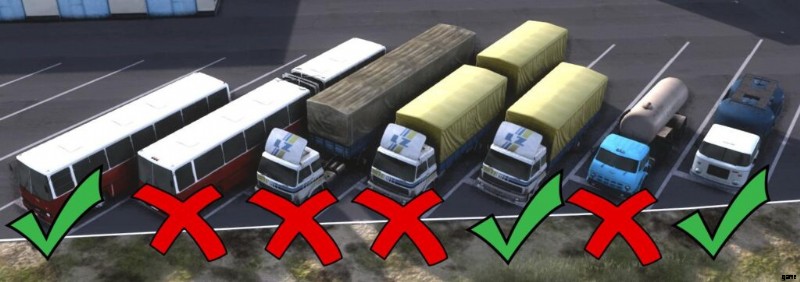
自家用車禁止

すべての自家用車を制限します。
バスなし

すべてのバスを制限します。
歩行者禁止

歩行者の通行を禁止します。なんらかの理由で人々がどこかを歩くことを禁止したいという非常に特殊な状況でない限り、これは主にロールプレイングの目的であるため、歩行者は高速道路の交差点を渡ることはありません.
補給以外の乗り物禁止


これらは、標準のカウンターパートのように機能します。ただし、アクセスが必要な車両はアクセスできます。
言い換えると、トラックは、必要がない限り、この標識のそばを通り過ぎないようにします。
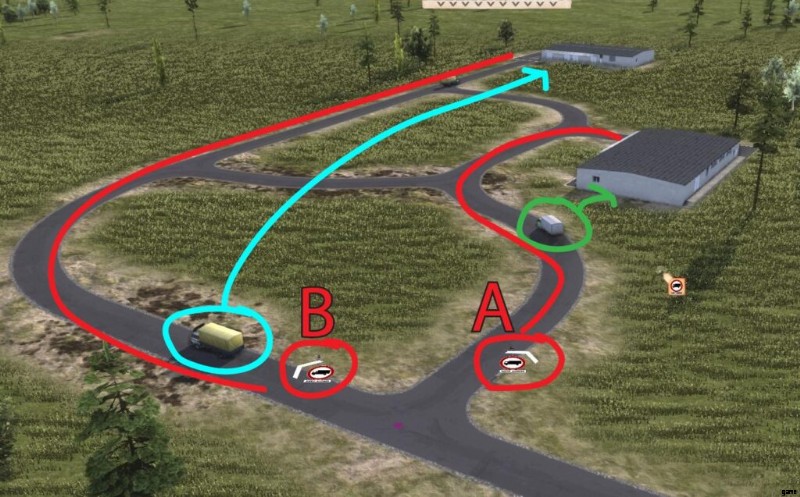
この例では、W50 は近くの倉庫 (緑) に向かい、LZ 100 は遠くの倉庫 (シアン) に向かう必要があります。 W50 は標識 A を通過することが許可されています。倉庫がすぐ後ろにあるため、彼は「供給」していると見なされます。
LZ 100 は標識 A を通り過ぎることはできません。シアンの貯蔵庫は遠く離れているためです。だから彼は別の道を歩まなければならない。標識 B も技術的にアクセスを制限していますが、他に取るべき道がないため、彼は供給と見なされ、標識は彼の通過を許可します (交通ロジックの詳細は後述します)。
体重制限



指定重量以下の車両のみ通行可能。空の重量ではなく、現在の重量を考慮します。
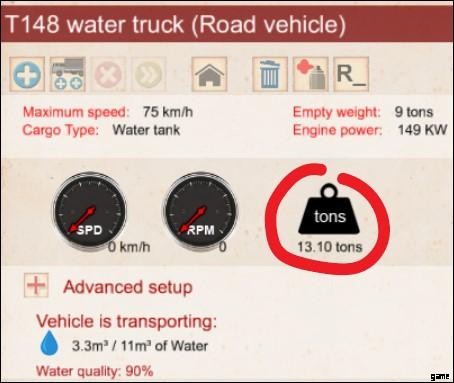
Q/E で増減できます。これまでに見つけた直接的な使用法は非常に限定的で難解です。主にロールプレイングの目的のようです (たとえば、特定のブリッジの最大重量を指定するなど)。しかし、おそらく、貨物を積んだ車両と積んでいない車両を除外するなど、非常に特殊でユニークな状況で使用できる可能性があります。
最低速度制限


現在、この速度に達する能力がある車両のみが通過できます。これは、古すぎたり、重すぎたり、満員だったりするために遅すぎる車両は通過できないことを意味します。これの使用法は、混雑した高速道路で、交通を遅くする動きの遅い車両をなくすことです。
Q/E で増減できます。
自動車禁止

通常の車両を制限します。これには、通常のトラック、バス、自家用車などが含まれます。通常の車両の通行を禁止するだけでなく、「歩行者専用」の道路を指定したり、道路を一時的に封鎖したりするために使用される可能性があります。ただし、通常の例外が適用されます。以下を参照してください。
例外
特定の車両は、すべてまたは特定の規則に従うことを完全に免除されています。これは、たとえば、自動車通行止めの標識を通過することが許可されていることを意味します。
- 消防車や救急車などの緊急車両は、すべての交通標識を無視します。
- シークレット パトカーやテクニカル サービス トラック (上下水道、除雪車) などの実用車は、すべての制限を無視しますが、速度制限を守り、ルールを追い越します。
- Very small trucks, like the B1000 truck, or the Mcar 25, or the IMV 22, in general any truck or utility vehicle (e.g. roller) that’s less than 2t ignores all restrictions, but still abides by speed limits and overtake rules. However the one restriction they do still follow is the minimum speed restriction; so the only thing you can ban the Mcar 25 from is your highway.
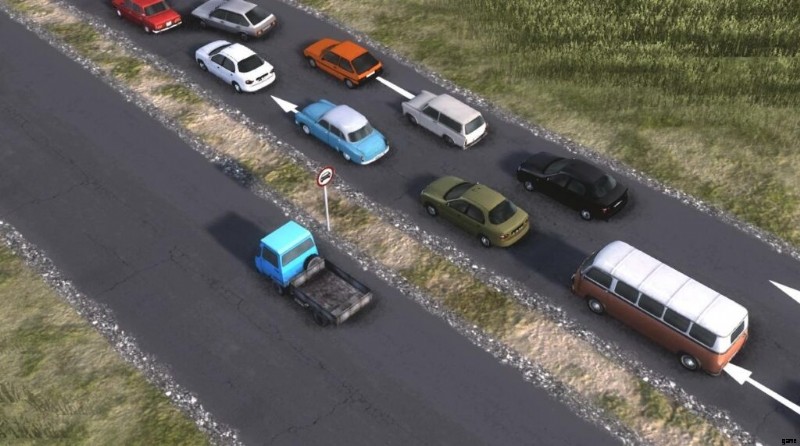
Multicar gives zero ♥♥♥ about your laws.
Zones

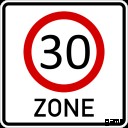
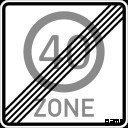
As mentioned in the Segmented Signs section, normal speed limit signs only apply to the current segment, and get forgotten by the next intersection or node.
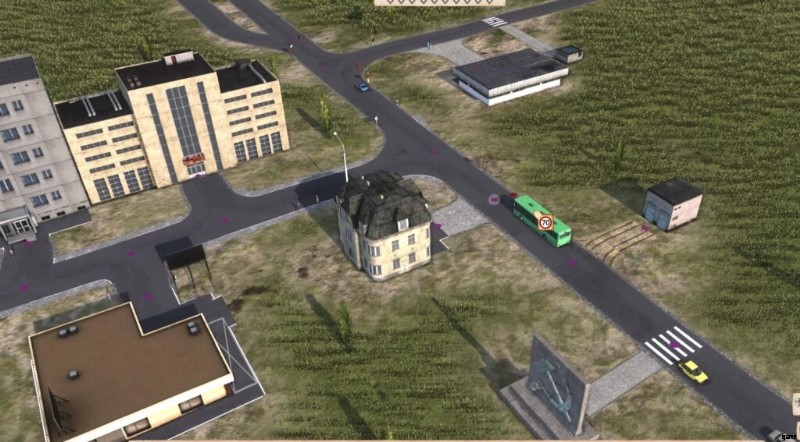
Placing a normal speed limit sign in this kind of street is somewhere between impossible and pointless. But exactly for this there are zones.
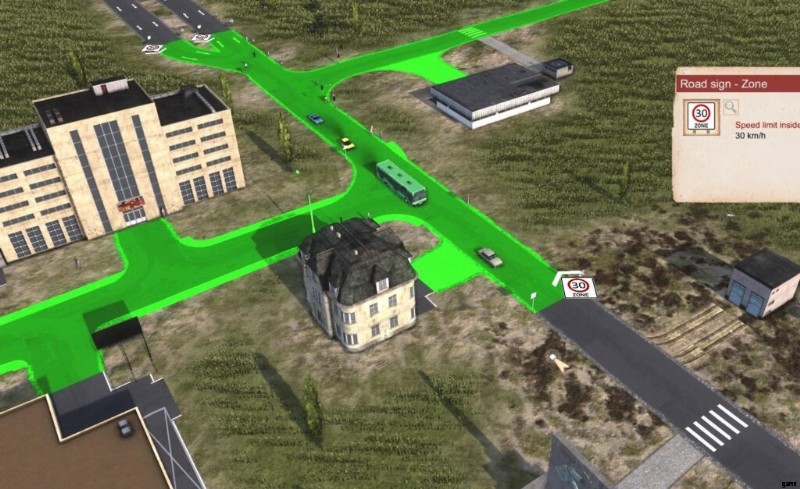
Zones apply their speed limit to all the streets they encompass.
For them to work, the area needs to be properly enclosed.
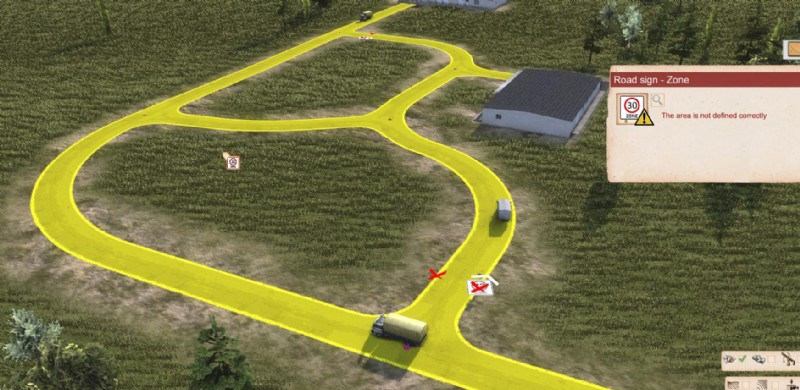
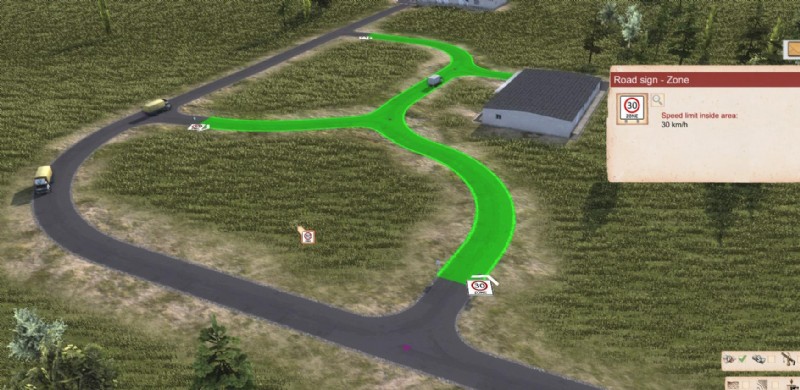
The zone entry signs can be clicked on, to see an overlay of the zone, and see any potential error.
Even if a street is a one-way street leading away from a zone, the zone sign still needs to “point” at the direction of the zone.
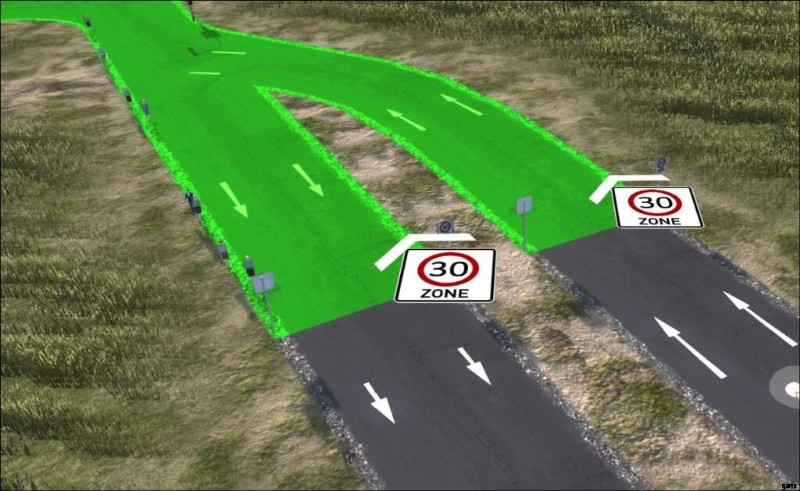
There are two type of zones.
Speed Limit Zones


Speed Limit Zones force vehicles to drive a below the designated speed limit within the zone. The limit can be decreased or increased with Q/E.
City Limits

City Limits is type of zone with a 60km/h speed limit within it’s borders. From observation, it also seems vehicles will try to avoid driving through it, even if it’s faster despite the 60km/h limit.
The City Limits zone is also very nice for role-playing, because they add really neat city limit signs.
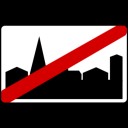
Interaction with other signs
If placed within a zone, normal speed limit signs will temporarily over-write the zone’s speed limit. Essentially, think of the zone as the new “default”.
This means if the speed limit sign is higher than the zone, cars will speed up on the following segment. If the speed limit sign is lower than the zone, cars will drive even slower on that street. A “End of Restriction” sign, will only end the speed limit sign, and re-apply the zone’s speed limit.
City Limit Zones and Speed Limit Zones can overlap each other. However, the speed limit zone takes precedent.
This means, you can have Speed Limit Zones inside of the City Limit Zone, and within that zone you can have even shorter normal Speed Limit signs.
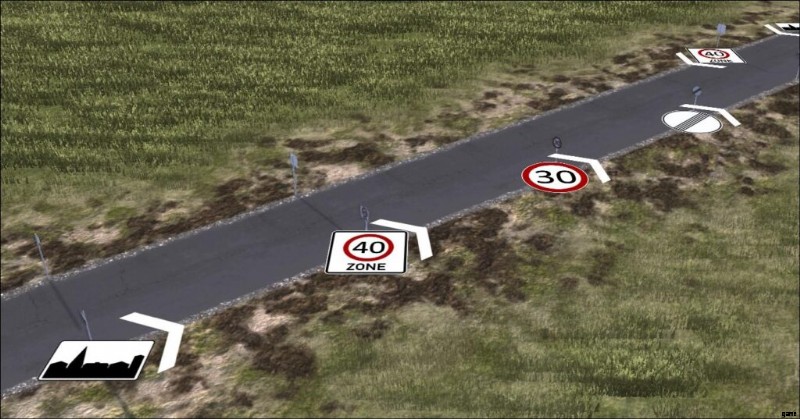
“Yo dawg, I heard you like speed limits, so I put a speed limit on your speed limit, so you can limit your speed while limiting your speed”
Priority Signs &Traffic Lights
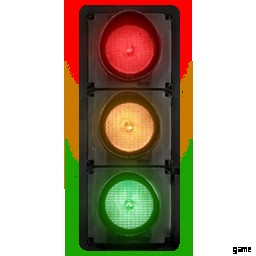
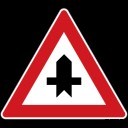
Any intersection can be edited by simply clicking on it. However, the quality of the road limits the type of signage that can be applied.
Multiple crossroads can be combined to a larger crossroad, if the space in between them would not make sense to have signage.
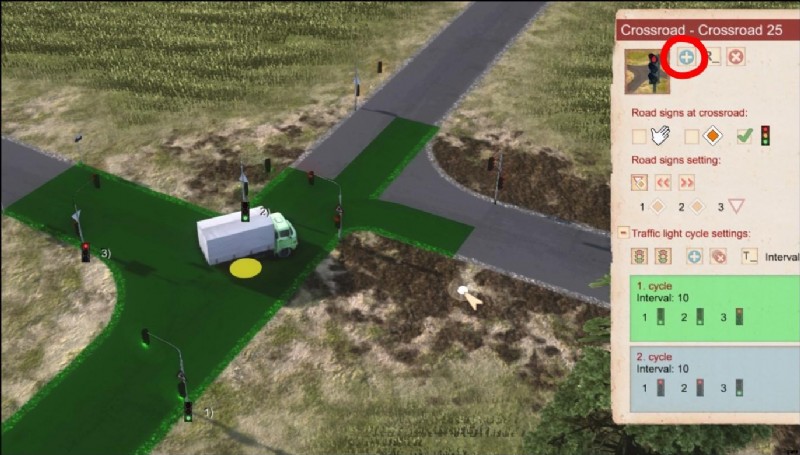
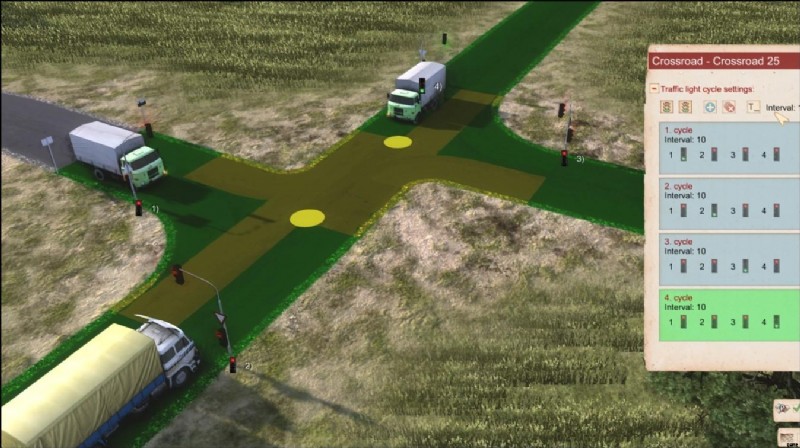
In the top picture, the truck is waiting in the middle of the street, because the 2nd crossroad’s traffic light is red.
In the bottom picture, the two crossroads have been combined into one larger one using the blue + sign. This means the traffic lights are at more sensible places, and the trucks are waiting at appropriate places.
As long as they are nearby, any number of crossings can be combined to a larger one.
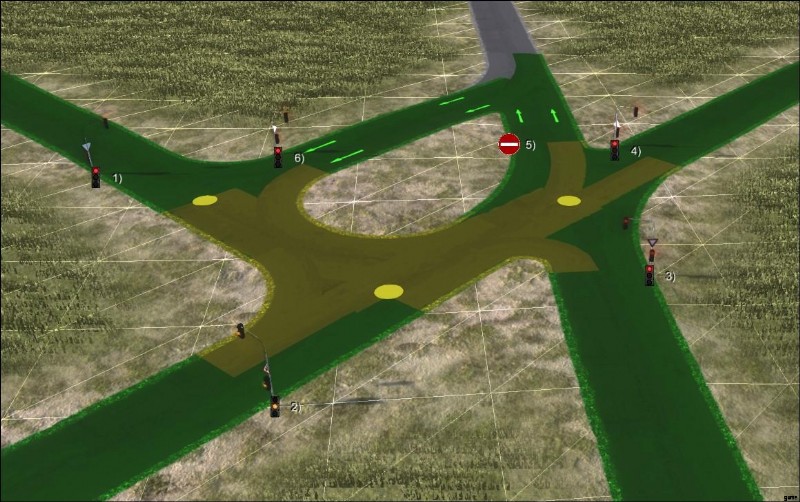
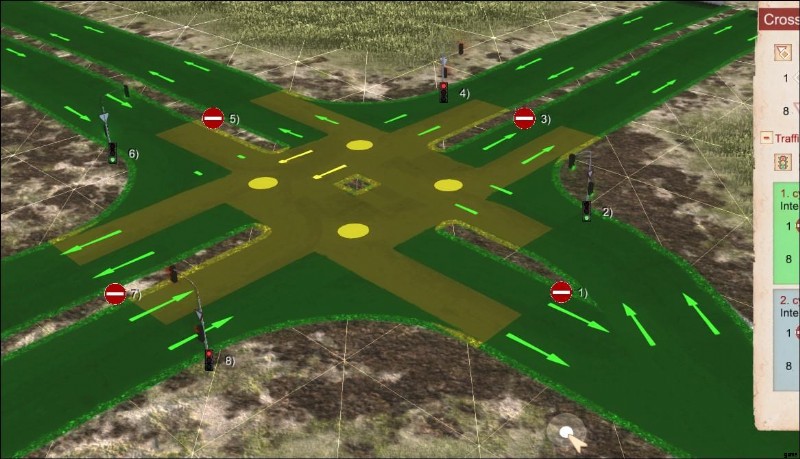
Priority To The Right

Without priority signs, traffic obeys normal Priority To The Right, meaning any vehicle is required to give way to vehicles approaching from the right at intersections.
Priority Signs

Any intersection that at least contains one gravel road, can have Priority Signs added to them.
Priority signs overwrite Priority to the Right. Each road is numbered and correlates to a number in the UI.
An intersection always needs two main roads. This unfortunately means one can not make 4-way stop intersections, although to be fair the reason for those existing in real life is to stop accidents, something that does not exist/matters in WR:SR.
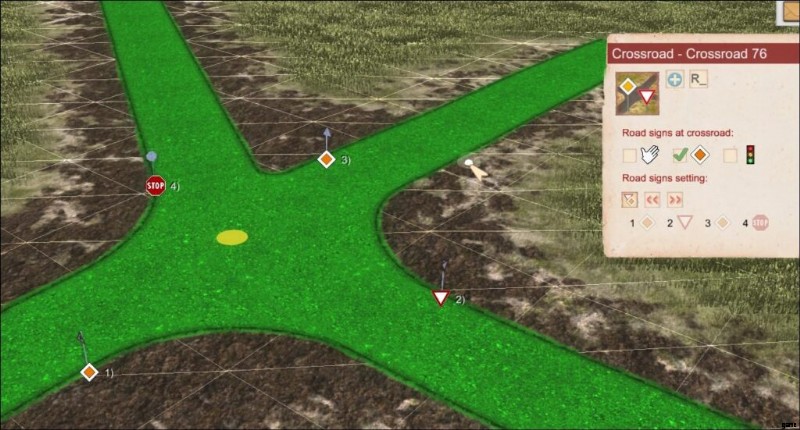
Vehicles heading horizontally have priority. Vehicles coming from the south need to come to a stop if there’s a vehicle on the priority road, but do not stop if there’s no one else. Vehicles coming from the top need to come to a complete stop, no matter if they’re alone or not.
Traffic Lights

Traffic Lights allow a better flow of traffic at dense intersections. An intersection needs to be completely asphalt. Further, if electricity is enabled in the game options, traffic lights need electricity. If there’s no power, the intersection will fall back to priority signs, which also need to be set up for traffic lights.
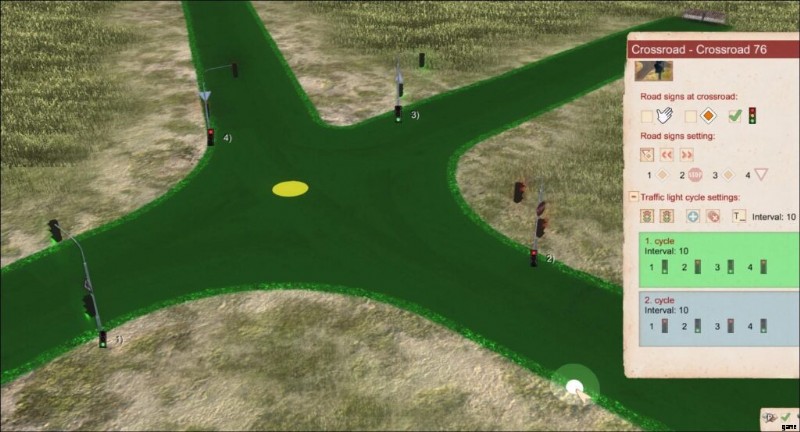
The same four way intersection, with a basic two active green lights setup. The priority signs are still there, in case the electricity goes out.
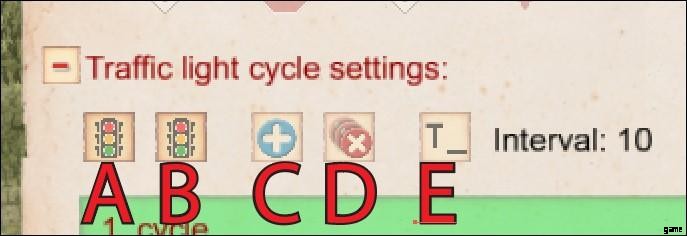
- A) Generate Pre-made template, where each road has it’s own cycle. Only one light is green, all other lights are red. This means there’ll be as many cycles as there are roads.
- B) Generate Pre-made template, where each cycle tries to have two green lights. This means technically double the throughput, assuming no vehicles drive into each other. If there’s an uneven amount of roads, the last cycle will only have one green light.
- C) Manually add a cycle
- D) Delete all cycles
- E) Set all cycles to this length
A traffic light crossroad is made up of multiple cycles, each cycle being one “setting”. Each cycle can have between zero or two green lights. After the interval, the traffic lights switch to the next cycle, until they’re all done and it loops.
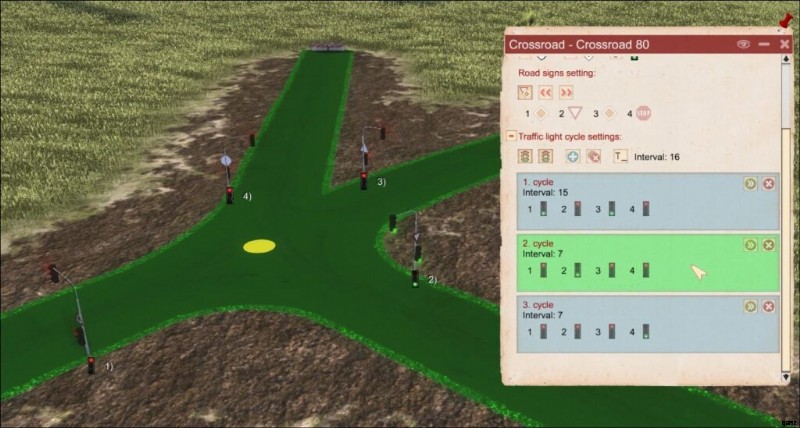
This example has three cycles.
- First cycle:The lights of road 1 and 3 are green, meaning the vehicles in both directions on the main road are allowed to drive. The north road (4) and the southern road (2) are both still red. This lasts for 15 seconds. After 15 seconds:
- Second cycle:The main road is now red (1,3), the north is still red (4), but the southern road (2) can drive. This lasts for 7 seconds.
- Third cycle:Now the north road (4) can finally drive.
- First cycle:North road (4) is back to red, south is red, main road is green again. Since the main road is supposed to have more vehicles, it’s cycle is as long as the other two combined.
There’s no limit to the amount of roads an intersection can have. There’s also no limit to the amount of cycles an intersection can have. And a cycle can even be completely red, if for some reason you just want all the drivers to stare at each other.
One-way streets going off the intersection do not have and do not need lights.
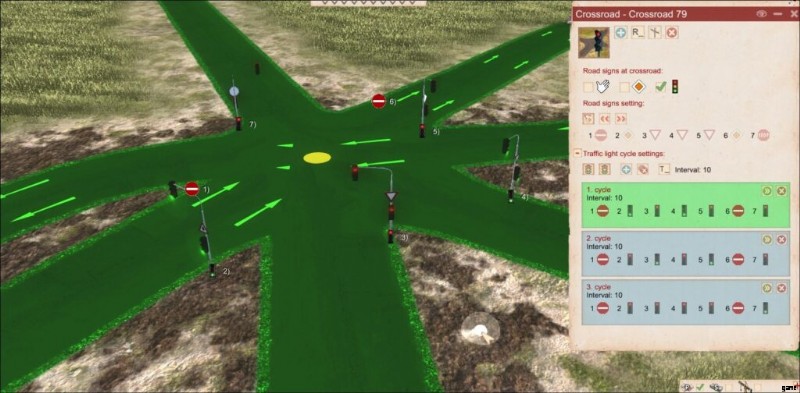
I call this one “the driving instructor’s torture weapon”
Traffic Logic and Conclusion
Traffic Logic
The game’s vehicles obey one rule:
- Find the fastest route I’m allowed to take
Vehicles don’t care about anything else. They don’t care about distance. They do not care about road type. They do not care about traffic.
Further, they only take into consideration their current maximum potential speed. This means, if some truck is fully loaded and can only drive 31km/h, it does not care if the fastest route is a mud road, a gravel road or a high speed one-direction asphalt highway. A vehicle also always has perfect knowledge of what’s ahead and knows the entire route and knows which roads it can take and what their speed limit is.
This means if there’s for example two roads to it’s destination, one going through a town with a 60km/h speed limit zone and even some 40km/h parts, and another road that goes around the town but has no speed limit, most vehicles will figure out going around the town is actually faster. Unless of course, we’re talking about our dumpy big fat truck from earlier, the one that can only drive 31km/h anyways. In it’s case, it might decide to just drive through the village. To prohibit that, one would also need to put “No Heavy Vehicles except Supply” at various parts of the town, potentially even at the entrance of it. Or one could put a Weight Limit sign infront of the town. Or a No Trailers.
The point is that the toolbox is large and diverse enough, that the same problem can be solved in a bunch of different ways. Most of it can be figured out through experimentation.
Like much of this amazing game, there’s no “one correct way” to do things.
Conclusion
Now what can and should you do with it?
Well… that’s really up to you, and the specific problems you are looking to solve at any given time and location.
Traffic lights are great at directing traffic, but a waste of time and electricity on a random rural road that only has one single random truck drive by once every 40 minutes. Even priority signs might be unnecessary in that situation.
At the entrance of a busy industrial area, you could have 3 separate roads leading into it. One for buses and private cars bringing workers, a separate one for the empty trucks, and one for the fully loaded trucks. The car/bus road could have “Heavy Cargo trucks” banned. The road for empty trucks could have a “Weight Limit” of 7t, which is exactly the LZ100 dumper semi-trailer truck, meaning any one of those with a full load would be banned from it. And the road for the full trucks, could have the “No Overtaking” sign alongside a “Speed Limit” of 50km/h, so the heavy fully loaded trucks are left alone and not interrupted.
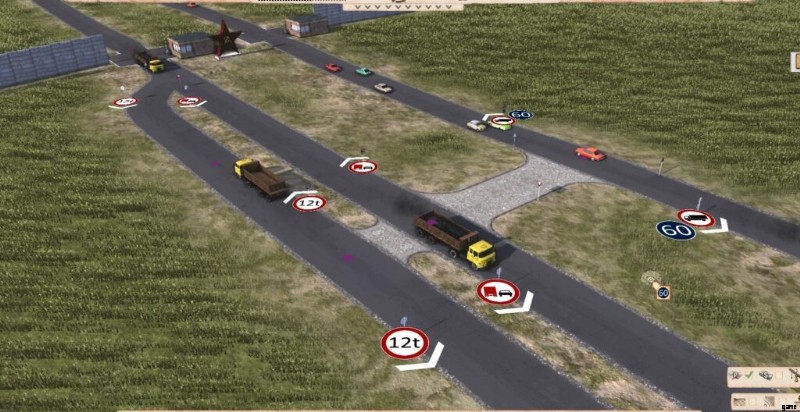
(Looking at it, one could even further optimize it by switching the two truck roads, since the empty ones are crossing the path of the full ones. Further, in this screenshot, there are no full ones heading towards the area and leaving empty)
You can have a large downtown area, which is part of a Speed Limit 40 zone, but has one large road going through it with a speed limit of 70. Meanwhile, all the side roads have the “No Heavy Cargo except Supplies”. And also, pedestrians are banned from just walking all over the fast road, and instead are told to use the safe bridges.
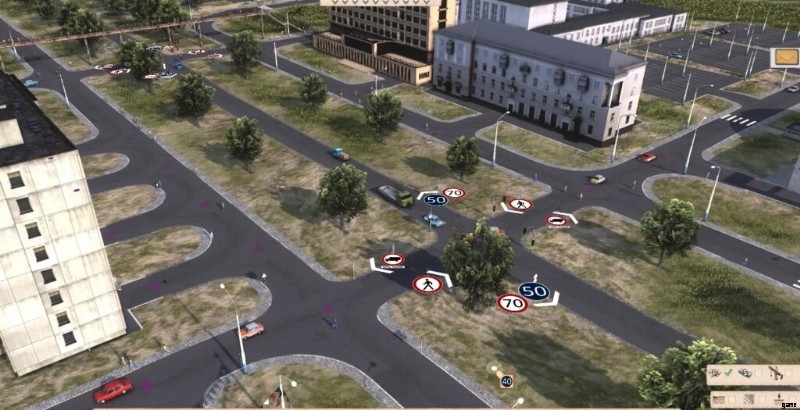
You can have one Distribution Office take from two different cargo station, one of the two is exclusive for smaller trucks, while the large trailer trucks are bound to the other one. This means the two types of trucks won’t clog each other up when picking up goods, but they’re still part of the same distribution office and can deliver to the same customers.
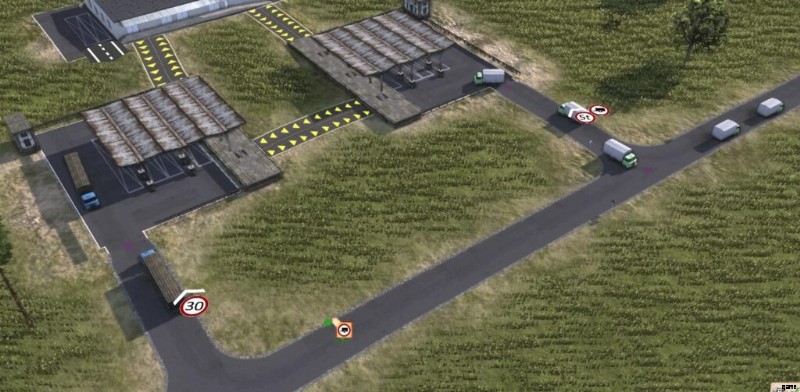
If you can think of any other interesting ways to use the traffic toolbox, do not hesitate to share it.
